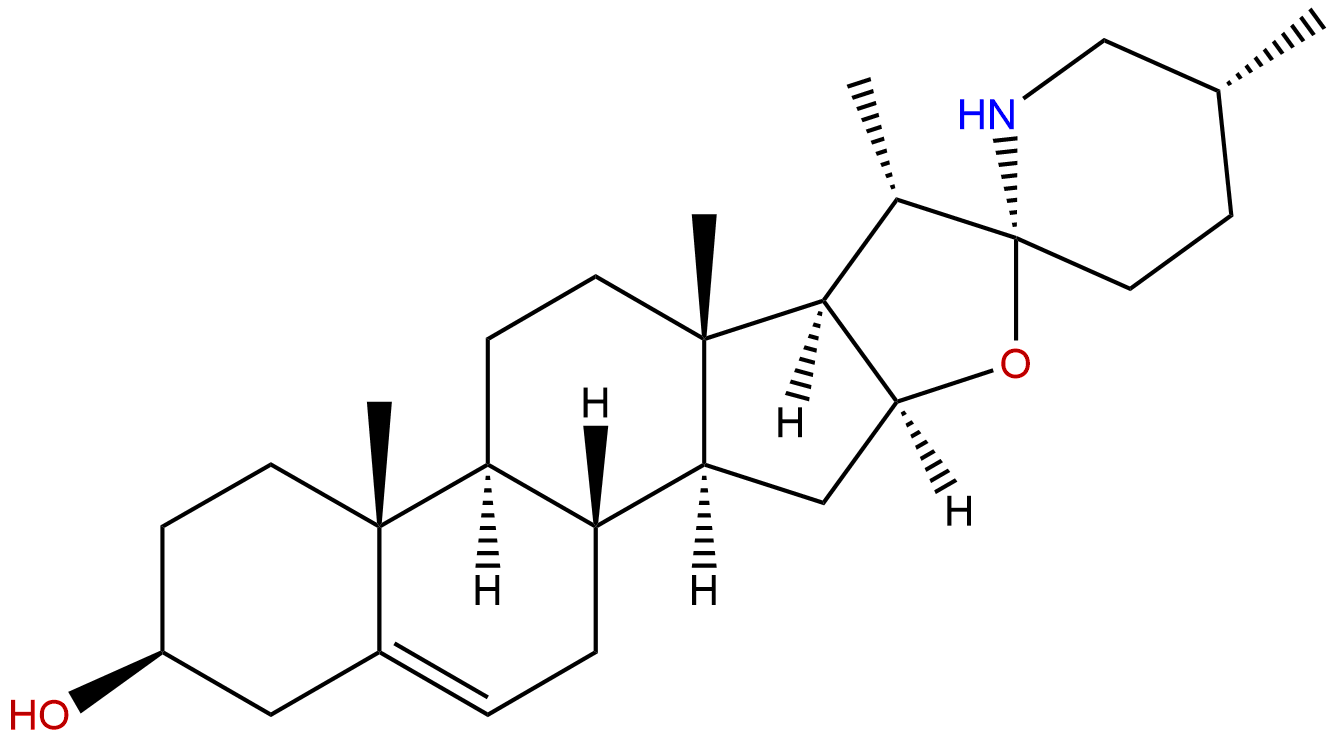
SolasodineCAS No.:126-17-0
|
||||||||||
 |
|
|
||||||||

| Catalogue No.: | BP1322 |
| Formula: | C27H43NO2 |
| Mol Weight: | 413.646 |
Product name: Solasodine
Synonym name: Solancarpidine; Purapuridine; Solanidine S; Solancarpine
Catalogue No.: BP1322
Cas No.: 126-17-0
Formula: C27H43NO2
Mol Weight: 413.646
Botanical Source: Solanum nigrum L.
Physical Description:
Type of Compound: Alkaloids
Purity: 95%~99%
Analysis Method: HPLC-DAD or/and HPLC-ELSD
Identification Method: Mass, NMR
Packing: Brown vial or HDPE plastic bottle
Storage: Store in a well closed container, protected from air and light. Put into refrigerate or freeze for long term storage.
Whenever possible, you should prepare and use solutions on the same day. However, if you need to make up stock solutions in advance, we recommend that you store the solution as aliquots in tightly sealed vials at -20℃. Generally, these will be useable for up to two weeks.
The product could be supplied from milligrams to grams
Inquire for bulk scale.
Description:
Solasodine has anticonvulsant, anti-oxidant, neuroprotection, and central nervous system depressant activities.Solasodine stimulates in situ neurogenesis from resident neuronal progenitors as part of neuron replacement therapy.
References:
J Chromatogr B Analyt Technol Biomed Life Sci. 2014 Jul 15;963:24-8.
Development and validation a liquid chromatography mass spectrometry for determination of solasodine in rat plasma and its application to a pharmacokinetic study.
Solasodine is a poisonous alkaloid chemical compound that occurs in plants of the Solanaceae family.
METHODS AND RESULTS:
A simple and selective liquid chromatography mass spectrometry method for determination of Solasodine in rat plasma was developed and validated over the range of 3-1,000 ng/mL. Chromatographic separation was achieved on a C18 (2.1 mm×50 mm, 3.5 μm) column with acetonitrile-0.1% formic acid in water as mobile phase with gradient elution. The flow rate was set at 0.4 mL/min. After addition of midazolam as internal standard (IS), liquid-liquid extraction by ethyl acetate was used as sample preparation. An electrospray ionization source was applied and operated in positive ion mode; selective ion monitoring mode was used for quantification with target ions m/z 414 for Solasodine and m/z 326 for IS. Mean recoveries of Solasodine in rat plasma were in the range of 87.6-94.1%. Matrix effects for Solasodine were between 94.9% and 102.3%. Coefficient of variation of intra-day and inter-day precision were both <13%. The accuracy of the method ranged from 94.4% to 105.3%.
CONCLUSIONS:
The method was successfully applied to a pharmacokinetic study of Solasodine after oral administration of 20mg/kg in rats.
Eur J Pharmacol. 2014 Feb 15;725:40-6.
Solasodine protects rat brain against ischemia/reperfusion injury through its antioxidant activity.
Ischemic stroke is the second leading cause of death worldwide. The major limitation of stroke management is the lack of clinically effective therapy. Antioxidants have been demonstrated as potent neuroprotective agents by enhancing the defense mechanism(s), whereas reducing the oxidative stress in the ischemic stroke models. In the present study, we evaluated neuroprotective potential of Solasodine, an antioxidant glycoalkaloid of Solanum species, against global model of ischemia in rats.
METHODS AND RESULTS:
Ischemia/reperfusion (I/R)-injury produced marked elevation in lipid peroxidation (LPO) and nitric oxide (NO), whereas superoxide dismutase (SOD), catalase (CAT), and glutathione (GSH) levels were decreased in experimental animals. Prior administration of Solasodine (100 and 200mg/kg, p.o.) significantly heightened SOD, CAT, GSH and total thiols, whereas reduced LPO and NO levels in the brain. Interestingly, brain coronal sectioning and histopathology studies revealed a marked reversal of I/R-provoked neuronal damage in the Solasodine treatment groups.
CONCLUSIONS:
Taken together, our study, for the first time, demonstrates neuroprotective potential of Solasodine against global ischemia-induced cerebral injury in experimental rats. We propose that the neuroprotection offered by Solasodine could be attributed, at least in part, to its anti-oxidant property.